
Welcome to Hyperion Records, a British classical label devoted to presenting high-quality recordings of music of all styles and from all periods from the twelfth century to the twenty-first.
Hyperion offers both CDs, and downloads in a number of formats. The site is also available in several languages.
Please use the dropdown buttons to set your preferred options, or use the checkbox to accept the defaults.

Notwithstanding his frustrating predicament, Stanford did his best to break the monotony of the chapel repertoire. Works such as Gibbons’ Hosanna to the Son of David, Stainer’s I saw the Lord, S S Wesley’s The Wilderness and Brahms’s How lovely are thy dwellings fair were introduced along with Stanford’s own ‘Queen’s’ service. A red-letter day, however, was to be 25 May 1879 when his Jubilate Deo and Te Deum in B flat, Op 10, were first sung at Matins. Later the same year, during the long vacation, the Te Deum was sung again with the Benedictus on the morning of 24 August and the Magnificat and Nunc dimittis were sung in the evening. The Service in B flat, Op 10, marked a major step forward in Stanford’s setting of the morning and evening canticles. As a composer he had fully assimilated the symphonic intellectualism of Brahms as evidenced by his first Symphony (1876), the Cello Sonata, Op 9 (1877), the Violin Sonata, Op 11 (1877), and the Piano Quartet, Op 15 (1879), and looked to adapt this compositional approach to the setting of familiar canticle texts and the ordinary of the communion service. In bringing an instrumental orientation to the music of the Anglican liturgy, Stanford challenged the accepted norm of ‘choral’ primacy where emphasis on the words, the clarity of their delivery, meaning and, most of all, their comprehension was paramount. This is not to say that Stanford (any more than his hero Brahms) ignored the textual dimension—far from it—but other issues, such as the sense of musical and structural cohesion came to warrant equal consideration. To add weight to this change of emphasis, the organ was emancipated from its customary accompanimental role and, building on the example of Walmisley’s Evening Service in D minor, assumed instead one of quasi-orchestral character. This not only suited Stanford’s own colourful style of organ-playing inherited from Stewart, but also exploited the resources of the new instrument at Trinity. A further feature of the Service in B flat is the parallel drawn between the various canticles and conventional symphonic movement style-forms. The Te Deum is, for example, analogous in tempi and treatment to a first-movement Allegro, the Magnificat, a Scherzo (a ternary structure in which the Gloria functions as a recapitulation) and the Nunc dimittis, a slow movement. Other unifying elements include the repetition of the Gloria (in the Benedictus, Jubilate Deo and Nunc dimittis), the cyclic reference to common material and specific tonalities (notably D flat and C major) shared among the individual movements, and, special to the Service in B flat, the prevalence of Gregorian material (for example, the intonation to the Te Deum and the ‘Dresden Amen’ used in the Gloria).
from notes by Jeremy Dibble © 1997
En 1879, Stanford, alors organiste de Trinity College (Cambridge), réunit dans son Service en si bémol op. 10 trois des cantiques pour les matines (Te Deum, Benedictus et Jubilate), le Service de communion et les cantiques de l’Evensong (Magnificat et Nunc dimittis). Comme l’a montré Jeremy Dibble, spécialiste du compositeur, ce service incarna une absolue nouveauté: l’application de la technique symphoniqe brahmsienne à la musique chorale sacrée. D’où un rare degré de cohésion structurelle qui distingue cette œuvre du gros de la musique liturgique de son temps. L’orgue prend, en outre, de l’importance, passant du rôle de simple accompagnateur à celui de protagoniste au caractère orchestral. Pour pousser un peu plus avant l’image symphonique, Dibble suggère de considérer le Te Deum comme un premier mouvement symphonique allegro—confiant et massif mais avec des passages contrastifs d’une grande délicatesse (ainsi le «We therefore pray thee, help thy servants» du quatuor solo)—, le Jubilate et le Magnificat comme le scherzo et le menuet, et le Nunc dimittis comme le mouvement lent, tous étant reliés par une doxologie («Glory be to the Father») pleine de dignité, avec son Amen final de «Dresde», hommage explicite à la tradition allemande.
extrait des notes rédigées par James O'Donnell © 2010
Français: Hypérion
Der Service in B-Dur op. 10 entstand 1879, als Stanford als Organist des Trinity College in Cambridge tätig war und es gibt darin drei Lobgesänge für die Morgenandacht (das Te Deum, Benedictus und Jubilate), den Abendmahlsgottesdienst und die Lobgesänge für die Abendandacht, das Magnificat und Nunc dimittis. Der Stanford-Forscher Jeremy Dibble hat darauf hingewiesen, dass in diesem Service etwas Neues geschieht, nämlich das Verwenden einer Brahms’schen symphonischen Technik in geistlicher Chormusik. Es verleiht dies der Musik einen ungewöhnlich starken strukturellen Zusammenhalt und besondere Bedeutung, was sie von dem Großteil der Kirchenmusik der damaligen Zeit absetzt. Die Orgel nimmt auch eine gewichtigere Rolle an und ist nicht mehr nur für die Begleitung zuständig, sondern tritt als musikalischer Protagonist mit orchestralem Charakter auf. Dibble dehnt die symphonische Metaphorik noch etwas weiter aus und schlägt vor, dass man das Te Deum als einen ersten Satz, als Allegro, einer Symphonie auffassen könnte—es ist selbstbewusst und groß angelegt, weist jedoch auch gegensätzliche Passagen von beträchtlicher Zartheit auf (wie etwa das Soloquartett „Dich bitten wir denn, komm deinen Dienern zu Hilfe“). Ferner könnten das Jubilate als das Scherzo, das Magnificat als Menuett und das Nunc dimittis als der langsame Satz verstanden werden. Alle sind durch eine würdevolle Vertonung der Doxologie („Ehre sei dem Vater“) miteinander verbunden, wobei am Schluss das sogenannte Dresdner Amen zum Einsatz kommt, was explizit der deutschen Tradition Tribut zollt.
aus dem Begleittext von James O'Donnell © 2010
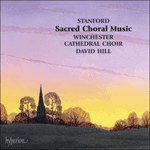 Stanford: Sacred choral music Stanford: Sacred choral musicThis three-disc set contains a generous selection of Stanford’s sacred choral music—settings for Matins, Evensong, motets, anthems and hymns—perfectly performed by Winchester Cathedral Choir at its best, conducted by David Hill.» More |
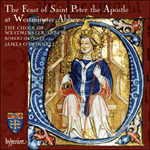 The Feast of Saint Peter the Apostle at Westminster Abbey The Feast of Saint Peter the Apostle at Westminster AbbeyAnother fascinating collection from Westminster Abbey, recreating a particular liturgical event. This disc contains music one might hear if visiting the Abbey on its patronal feast, that of St Peter the Apostle. The programme broadly follows the s ...» More |
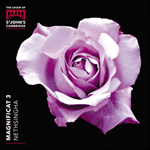 Magnificat, Vol. 3 Magnificat, Vol. 3Seven glorious—and diverse—settings of the Evening Canticles are prefaced by a rarity from pre-Revolutionary Russia, and all in performances of the utmost integrity and vigour.» More |
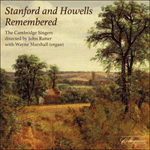 Stanford and Howells Remembered Stanford and Howells RememberedThis newly remastered version of The Cambridge Singers' 1992 Stanford and Howells album has been expanded to include almost twenty minutes of previously unreleased material, including Stanford's resplendent Latin Magnificat. John Rutter and The Ca ...» More |
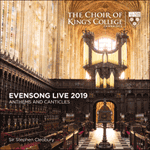 Evensong Live 2019 Evensong Live 2019A new collection of sixteen anthems and canticles, specially selected from the daily live recordings made in the glorious Chapel of King's College Cambridge during the past year.» More |

